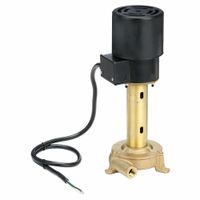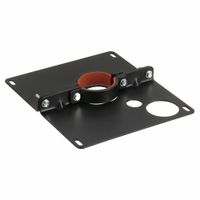Call +(254) 703 030 000 / 751 483 999 / 721 704 777
- Home
- Machining
- Coolant Systems Accessories
- Machine Tool Coolant Pumps Mounting Brackets
.....Read More
Frequently Asked Questions
What is the purpose of a machine tool coolant pump?
The purpose of a machine tool coolant pump is to circulate coolant fluid in machining processes to manage heat and remove debris. During operations like milling, drilling, or turning, significant heat is generated due to friction between the cutting tool and the workpiece. This heat can lead to thermal expansion, affecting precision and potentially damaging both the tool and the workpiece. The coolant pump helps mitigate these issues by delivering coolant to the cutting zone, which absorbs and dissipates heat, maintaining optimal temperatures.
Additionally, the coolant acts as a lubricant, reducing friction and wear on the cutting tool, thereby extending its lifespan and improving surface finish quality. The pump also aids in flushing away chips and debris from the cutting area, preventing them from interfering with the machining process and reducing the risk of tool breakage or workpiece damage.
Coolant pumps are designed to provide a consistent flow and pressure, ensuring that the coolant reaches all necessary areas of the machine tool. This is crucial for maintaining uniform cooling and lubrication, especially in complex or high-speed machining operations. By maintaining a stable thermal environment and clean working conditions, the coolant pump enhances machining accuracy, efficiency, and safety, ultimately contributing to higher productivity and reduced operational costs.
How does a coolant pump prevent cutting tools from overheating?
A coolant pump prevents cutting tools from overheating by circulating a cooling fluid, typically a water-based or oil-based coolant, over the cutting area during machining processes. This fluid absorbs the heat generated by the friction between the cutting tool and the workpiece. The coolant serves several key functions:
1. **Heat Dissipation**: The primary role of the coolant is to absorb and carry away the heat produced during cutting. By maintaining a lower temperature, it prevents the cutting tool from reaching temperatures that could lead to thermal deformation or loss of hardness, which can compromise the tool's effectiveness and lifespan.
2. **Lubrication**: The coolant also acts as a lubricant, reducing friction between the tool and the workpiece. This minimizes the amount of heat generated in the first place, further protecting the tool from overheating.
3. **Chip Removal**: Coolant helps in flushing away chips and debris from the cutting area. This prevents the chips from being re-cut, which can generate additional heat and cause tool wear.
4. **Surface Finish**: By maintaining optimal temperatures and reducing friction, the coolant helps achieve a better surface finish on the workpiece, as excessive heat can lead to surface defects.
5. **Tool Life Extension**: By preventing overheating, the coolant extends the life of the cutting tool, reducing the frequency of tool changes and downtime, and improving overall productivity.
The coolant pump ensures a continuous and controlled flow of coolant, maintaining consistent temperature control and lubrication throughout the machining process. This system is crucial in high-speed or high-precision machining operations where thermal management is critical.
What types of coolant are used in machine tool systems?
Machine tool systems utilize various types of coolants to manage heat and improve machining performance. The primary types include:
1. **Water-Soluble Coolants**: These are the most common and include emulsifiable oils, semi-synthetics, and synthetics.
- **Emulsifiable Oils**: Oil-based concentrates mixed with water to form an emulsion. They provide good lubrication and cooling.
- **Semi-Synthetics**: A blend of mineral oil and synthetic fluids, offering a balance between lubrication and cooling.
- **Synthetics**: Contain no mineral oil, offering excellent cooling and cleanliness, but less lubrication.
2. **Straight Oils**: Also known as cutting oils, these are non-water-miscible and provide excellent lubrication. They are used in operations requiring high lubrication, such as threading and tapping.
3. **Synthetic Coolants**: Composed of chemical formulations without oil, these coolants offer superior cooling and are ideal for high-speed machining.
4. **Semi-Synthetic Coolants**: These combine the properties of synthetic and soluble oils, providing good lubrication and cooling.
5. **Gaseous Coolants**: Typically air or inert gases like nitrogen, used in dry machining to blow away chips and cool the tool and workpiece.
6. **Cryogenic Coolants**: Utilize substances like liquid nitrogen or carbon dioxide to achieve extremely low temperatures, reducing thermal distortion and tool wear.
7. **Vegetable-Based Coolants**: Derived from renewable resources, these are environmentally friendly and provide good lubrication and cooling.
Each type of coolant has specific applications based on the material being machined, the machining process, and environmental considerations. Proper selection and maintenance of coolants are crucial for optimal machine tool performance and longevity.
How does coolant filtration work in a machine tool system?
Coolant filtration in a machine tool system involves removing contaminants from the coolant to maintain its effectiveness and extend the life of both the coolant and the machine. The process typically includes several stages:
1. **Pre-Filtration**: Large particles such as metal chips and swarf are removed using screens or magnetic separators. This prevents clogging and damage to downstream filtration equipment.
2. **Primary Filtration**: The coolant passes through filters, such as bag or cartridge filters, which capture smaller particles. These filters are selected based on the size of particles they need to remove, often measured in microns.
3. **Secondary Filtration**: For finer filtration, systems may use hydrocyclones or centrifuges. These devices use centrifugal force to separate fine particles from the coolant, enhancing the removal of contaminants that primary filters might miss.
4. **Tramp Oil Removal**: Skimmers or coalescers are used to remove tramp oils that can contaminate the coolant. These devices separate oil from the coolant, preventing bacterial growth and maintaining coolant quality.
5. **Filtration Media**: Some systems use specialized filtration media, such as paper or fabric, to capture very fine particles. These media can be disposable or reusable, depending on the system design.
6. **Coolant Recycling**: After filtration, the clean coolant is recirculated back into the machine tool. This recycling process reduces waste and minimizes the need for fresh coolant, leading to cost savings and environmental benefits.
7. **Monitoring and Maintenance**: Regular monitoring of the filtration system ensures it operates efficiently. Maintenance tasks include replacing filters, cleaning separators, and checking for leaks or blockages.
By effectively filtering the coolant, the system ensures optimal machine performance, reduces wear on components, and maintains a clean working environment.
What are the common issues with machine tool coolant pumps?
Common issues with machine tool coolant pumps include:
1. **Clogging**: Coolant pumps often face clogging due to the accumulation of chips, debris, and sludge in the coolant. This can restrict flow and reduce efficiency.
2. **Leakage**: Seals and gaskets in the pump can wear out over time, leading to coolant leaks. This not only reduces the coolant level but can also cause environmental and safety hazards.
3. **Overheating**: Pumps can overheat due to continuous operation, insufficient lubrication, or blockages. Overheating can lead to premature wear and failure of pump components.
4. **Cavitation**: This occurs when there is a drop in pressure within the pump, causing vapor bubbles to form and collapse. Cavitation can damage the impeller and other internal components.
5. **Electrical Issues**: Problems such as motor failure, wiring faults, or power supply issues can disrupt pump operation. Electrical issues can lead to intermittent performance or complete pump failure.
6. **Wear and Tear**: Regular use leads to the natural wear of components like bearings, impellers, and seals. This wear can reduce pump efficiency and lifespan.
7. **Corrosion**: Exposure to certain coolants or environmental conditions can cause corrosion of pump components, leading to leaks and structural weakness.
8. **Vibration and Noise**: Excessive vibration and noise can indicate misalignment, imbalance, or worn components, which can lead to further mechanical issues.
9. **Improper Installation**: Incorrect installation can lead to alignment issues, improper sealing, and inefficient operation, causing premature failure.
10. **Inadequate Maintenance**: Lack of regular maintenance, such as cleaning, inspection, and part replacement, can exacerbate all the above issues, leading to reduced performance and increased downtime.
How do you maintain a machine tool coolant pump?
To maintain a machine tool coolant pump, follow these steps:
1. **Regular Inspection**: Check the pump and its components regularly for signs of wear, leaks, or damage. Look for unusual noises or vibrations that may indicate a problem.
2. **Coolant Quality**: Monitor the coolant quality. Ensure it is clean and free from contaminants. Replace or filter the coolant as needed to prevent clogging and corrosion.
3. **Filter Maintenance**: Clean or replace filters regularly to ensure proper flow and prevent debris from entering the pump. Clogged filters can reduce efficiency and cause damage.
4. **Seal and Gasket Check**: Inspect seals and gaskets for wear or leaks. Replace them if necessary to prevent coolant leakage and maintain pressure.
5. **Pump Alignment**: Ensure the pump is properly aligned with the motor and other components. Misalignment can cause excessive wear and reduce efficiency.
6. **Lubrication**: Lubricate moving parts according to the manufacturer's recommendations. Proper lubrication reduces friction and wear, extending the pump's lifespan.
7. **Electrical Connections**: Check electrical connections for tightness and corrosion. Ensure that the motor and controls are functioning correctly.
8. **Flow Rate and Pressure**: Monitor the flow rate and pressure to ensure they are within the specified range. Adjust settings if necessary to maintain optimal performance.
9. **Temperature Monitoring**: Keep an eye on the operating temperature. Overheating can indicate a problem with the pump or coolant system.
10. **Documentation**: Keep detailed records of maintenance activities, including inspections, repairs, and replacements. This helps in tracking the pump's condition and planning future maintenance.
11. **Training**: Ensure that personnel responsible for maintenance are properly trained and familiar with the pump's operation and maintenance procedures.
By following these steps, you can ensure the efficient and reliable operation of a machine tool coolant pump.
What are the benefits of using mounting brackets for coolant pumps?
Mounting brackets for coolant pumps offer several benefits:
1. **Stability and Support**: They provide a secure and stable platform for the pump, reducing vibrations and potential misalignment, which can lead to wear and tear.
2. **Ease of Installation**: Brackets simplify the installation process by providing a predefined mounting point, ensuring the pump is correctly positioned and aligned.
3. **Space Optimization**: They help in organizing the layout of machinery by allowing pumps to be mounted in optimal positions, saving space and facilitating better workflow.
4. **Maintenance Access**: Mounting brackets allow for easier access to the pump for maintenance and repairs, reducing downtime and improving serviceability.
5. **Vibration Reduction**: By securely holding the pump, brackets minimize vibrations, which can enhance the longevity of both the pump and connected components.
6. **Safety**: Properly mounted pumps are less likely to shift or fall, reducing the risk of accidents and ensuring a safer working environment.
7. **Customization**: Many brackets are adjustable or customizable, allowing for flexibility in pump positioning to meet specific operational needs.
8. **Corrosion Resistance**: High-quality brackets are often made from materials that resist corrosion, protecting the pump and extending its lifespan.
9. **Cost Efficiency**: By reducing wear and tear and facilitating easier maintenance, mounting brackets can lead to cost savings over time.
10. **Enhanced Performance**: Proper mounting ensures optimal pump performance by maintaining correct alignment and reducing mechanical stress.
Overall, mounting brackets are essential for ensuring the efficient, safe, and long-lasting operation of coolant pumps in various industrial applications.

